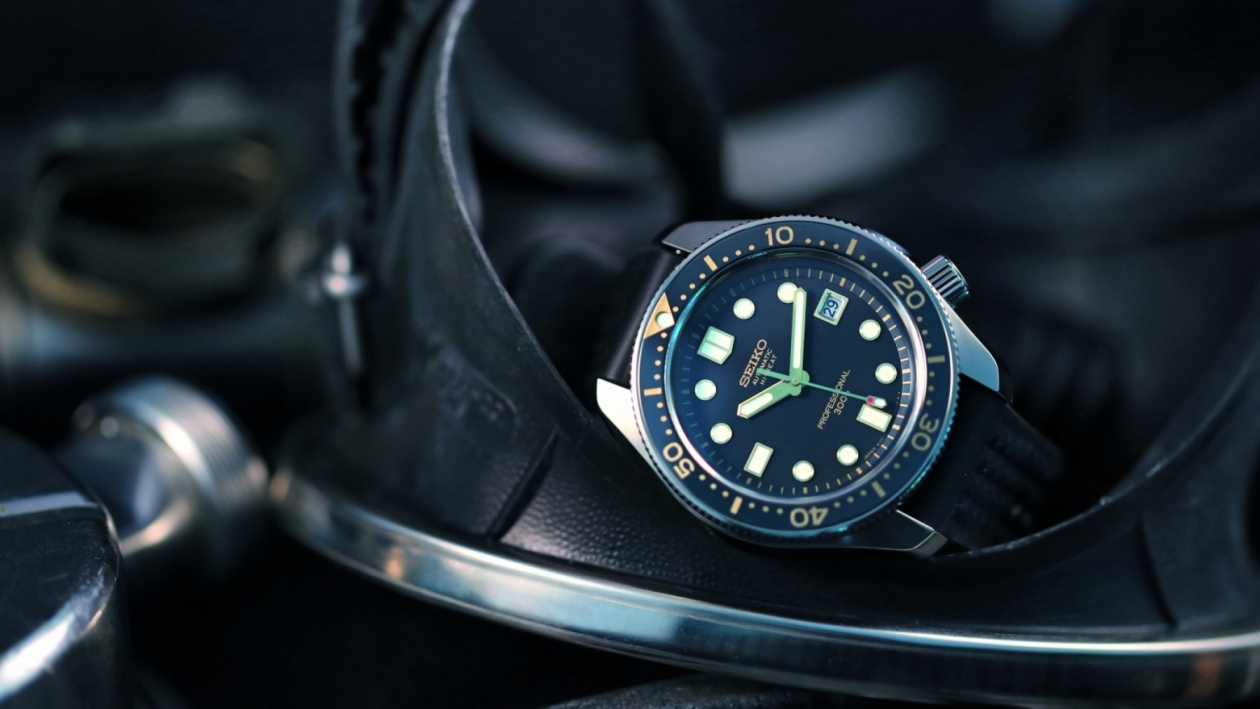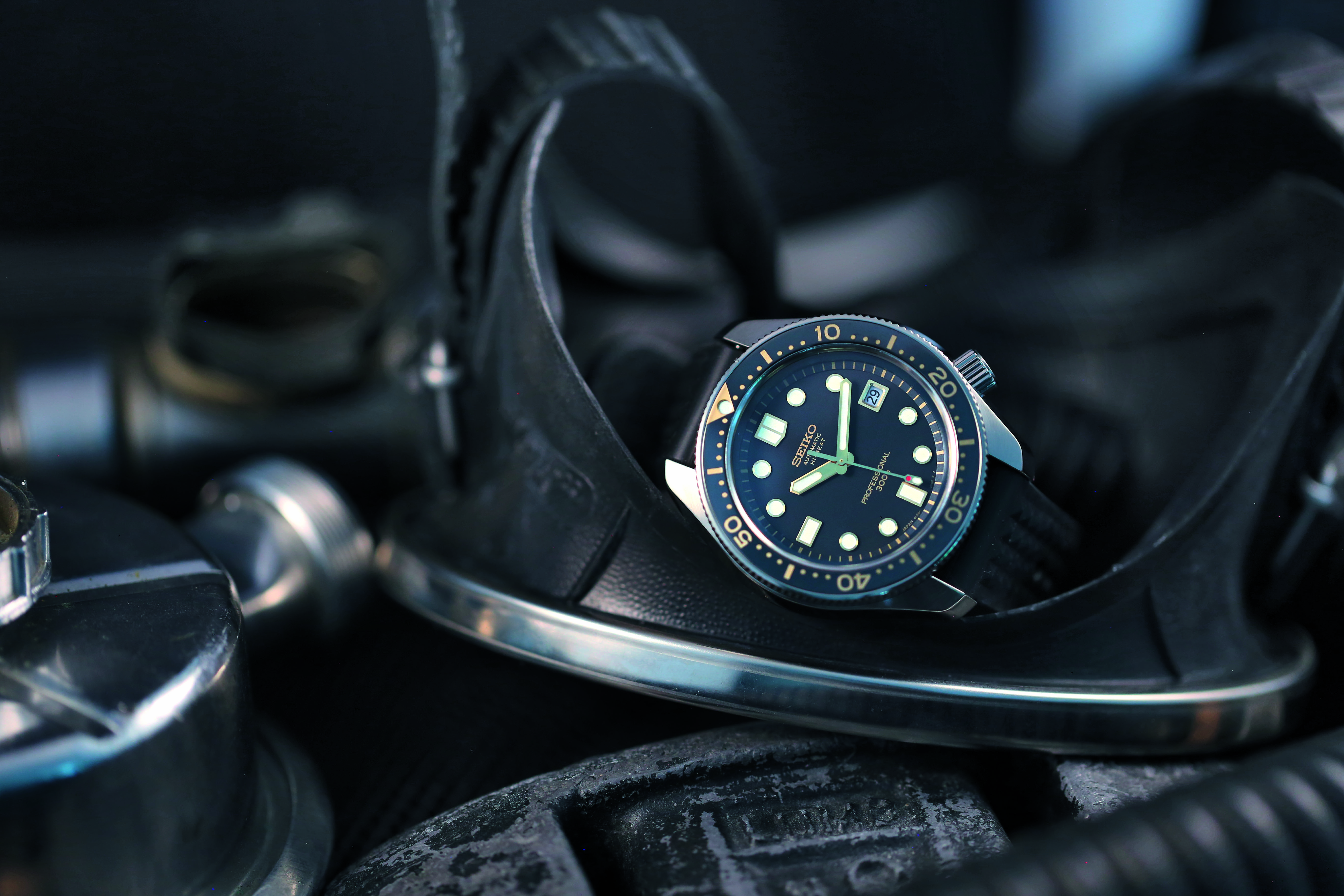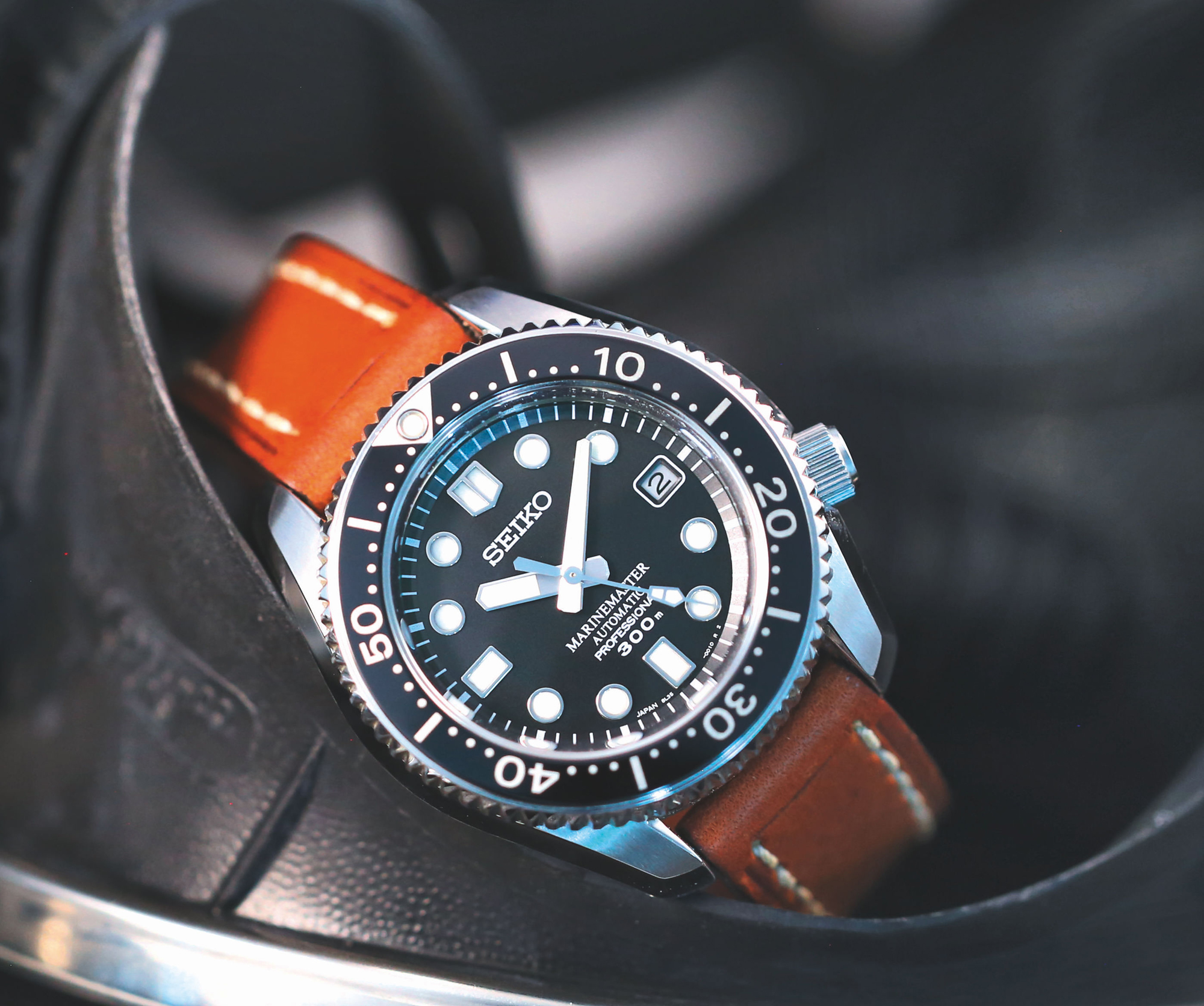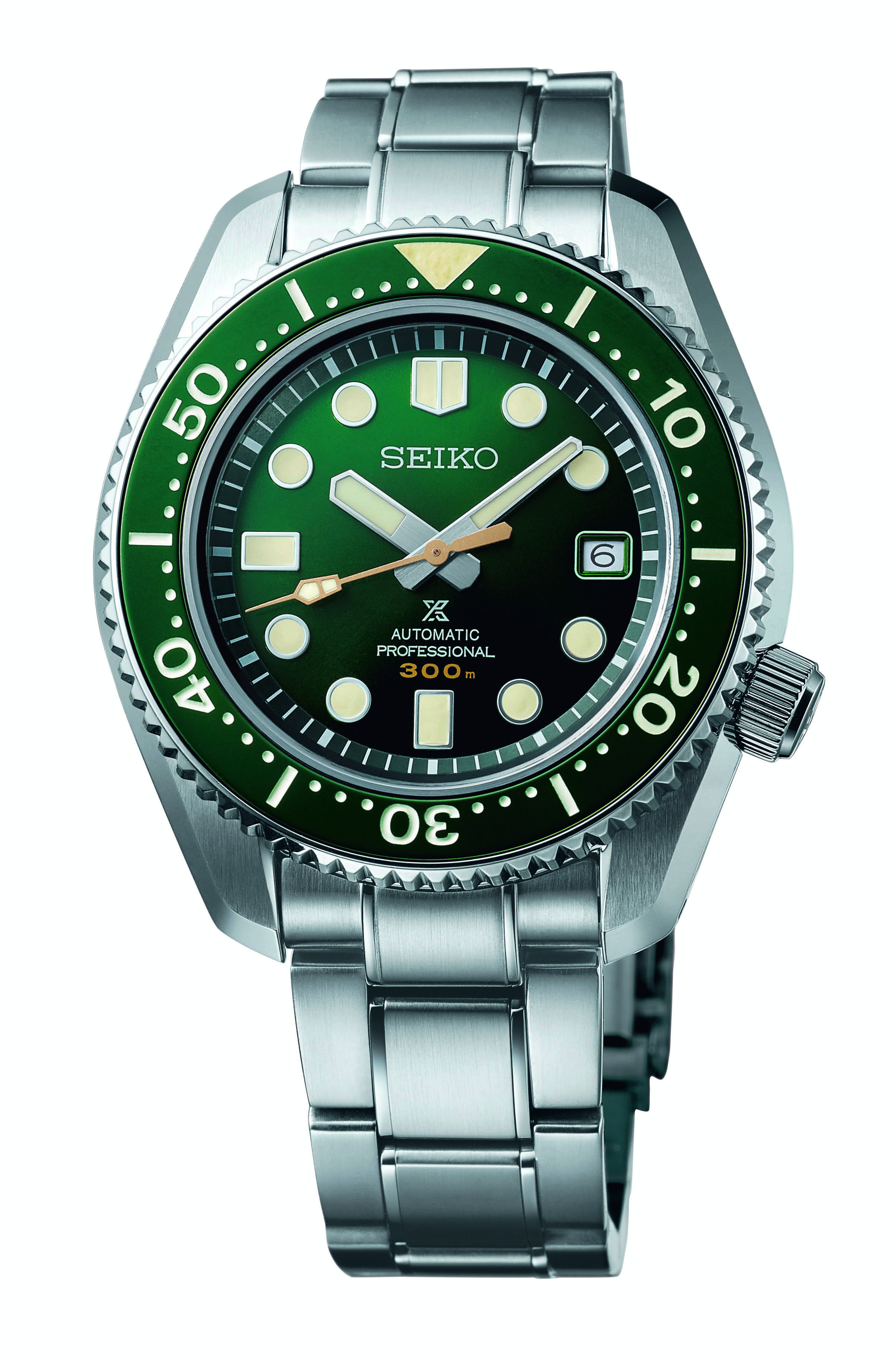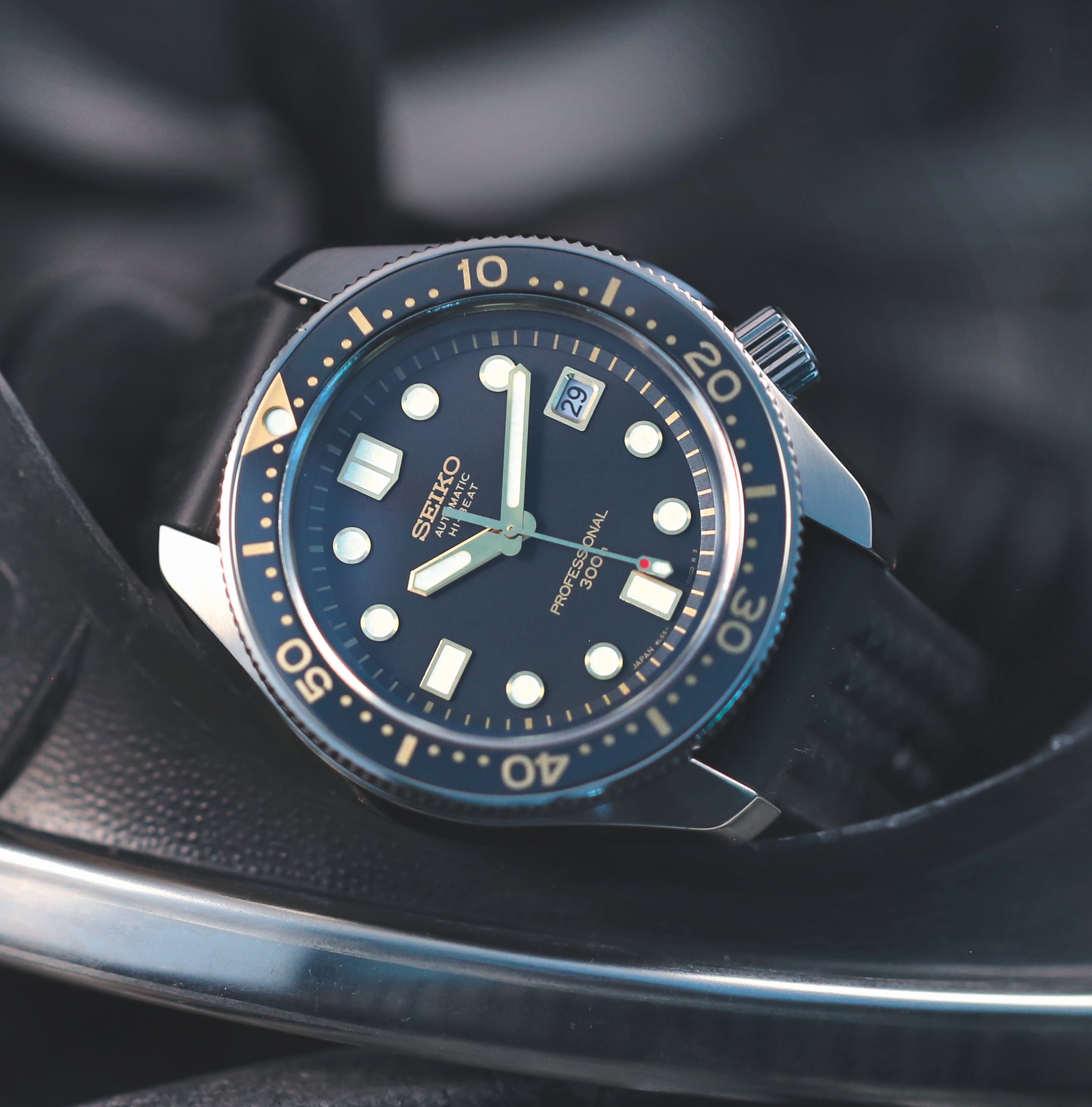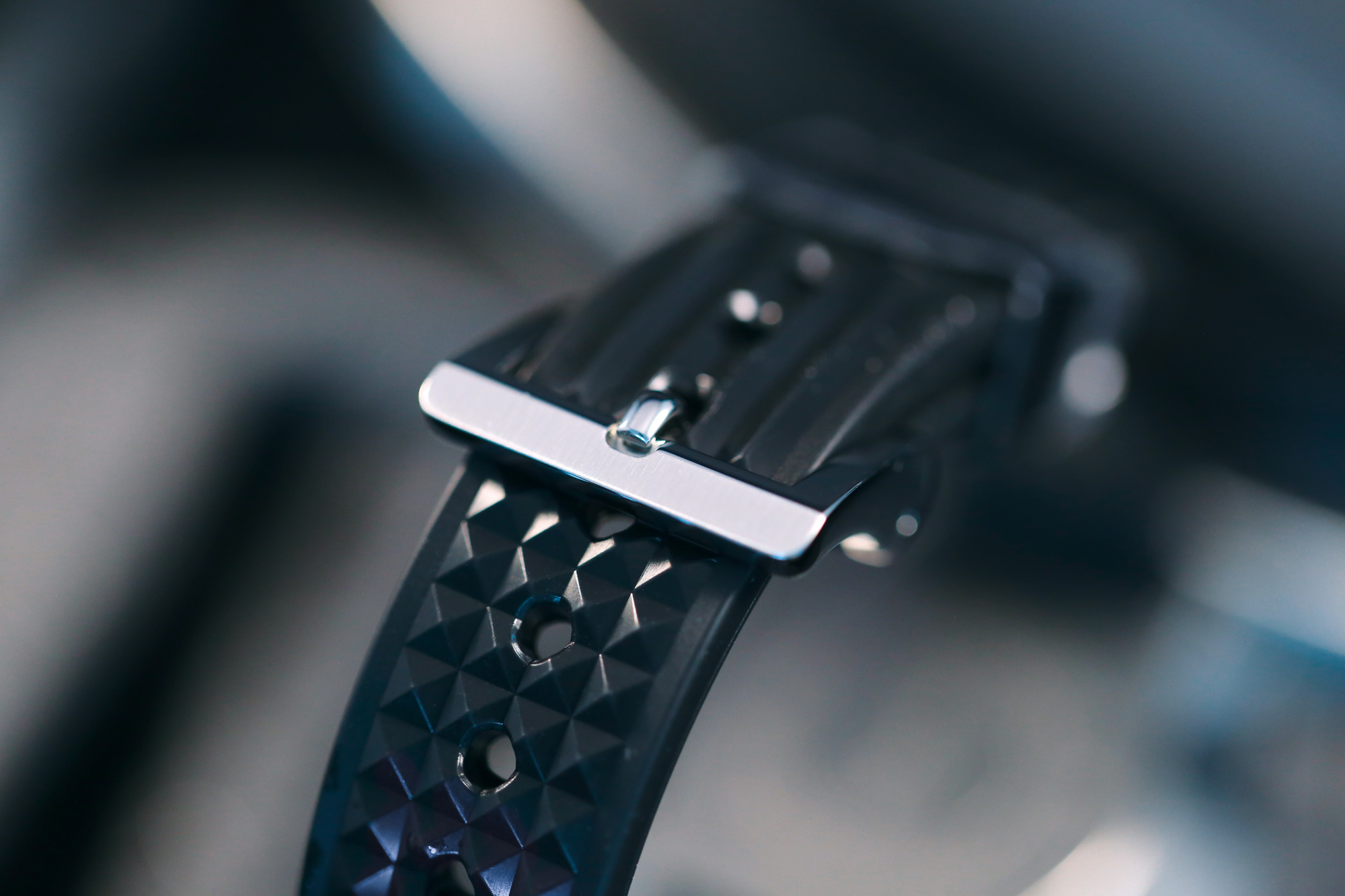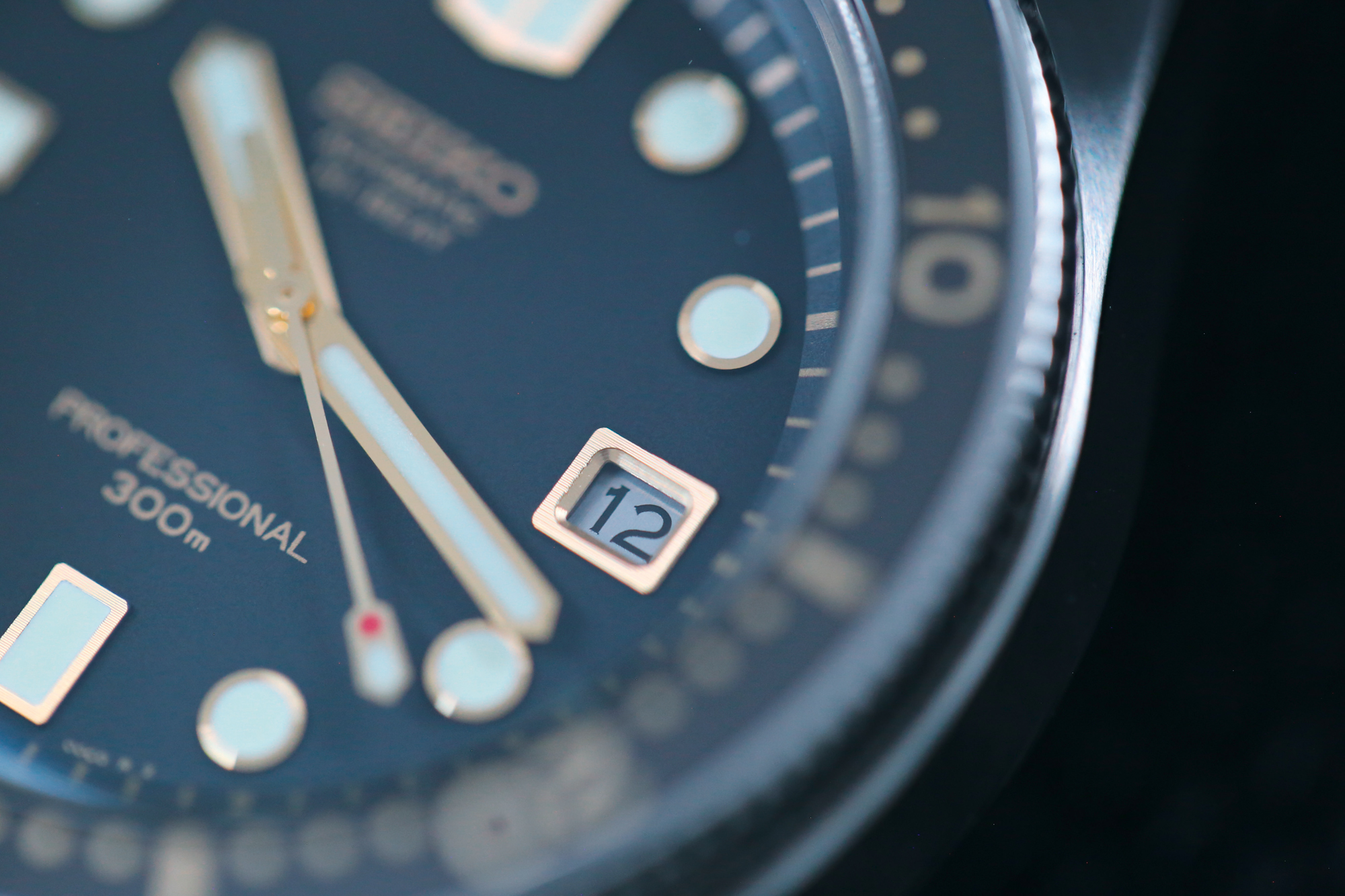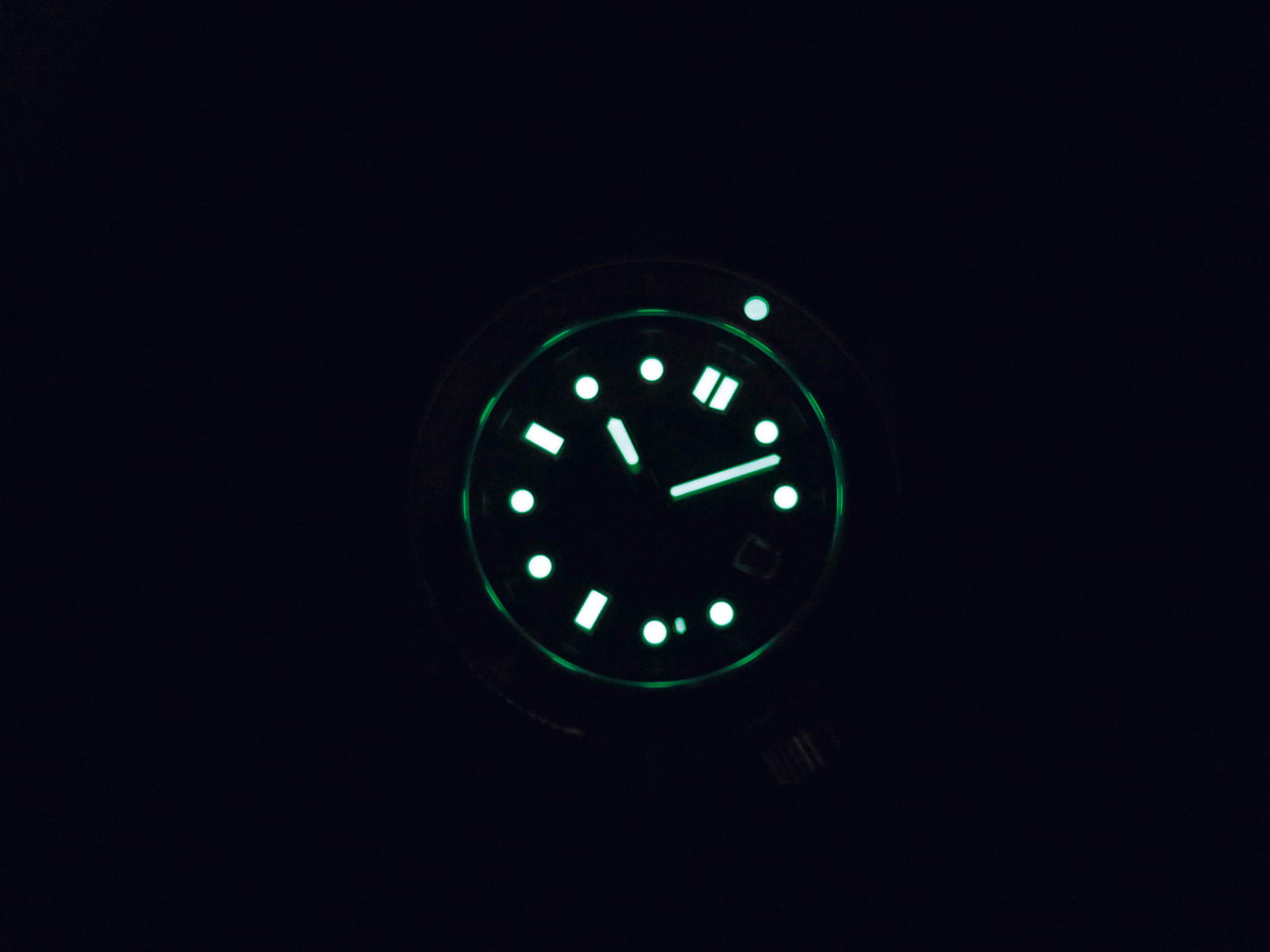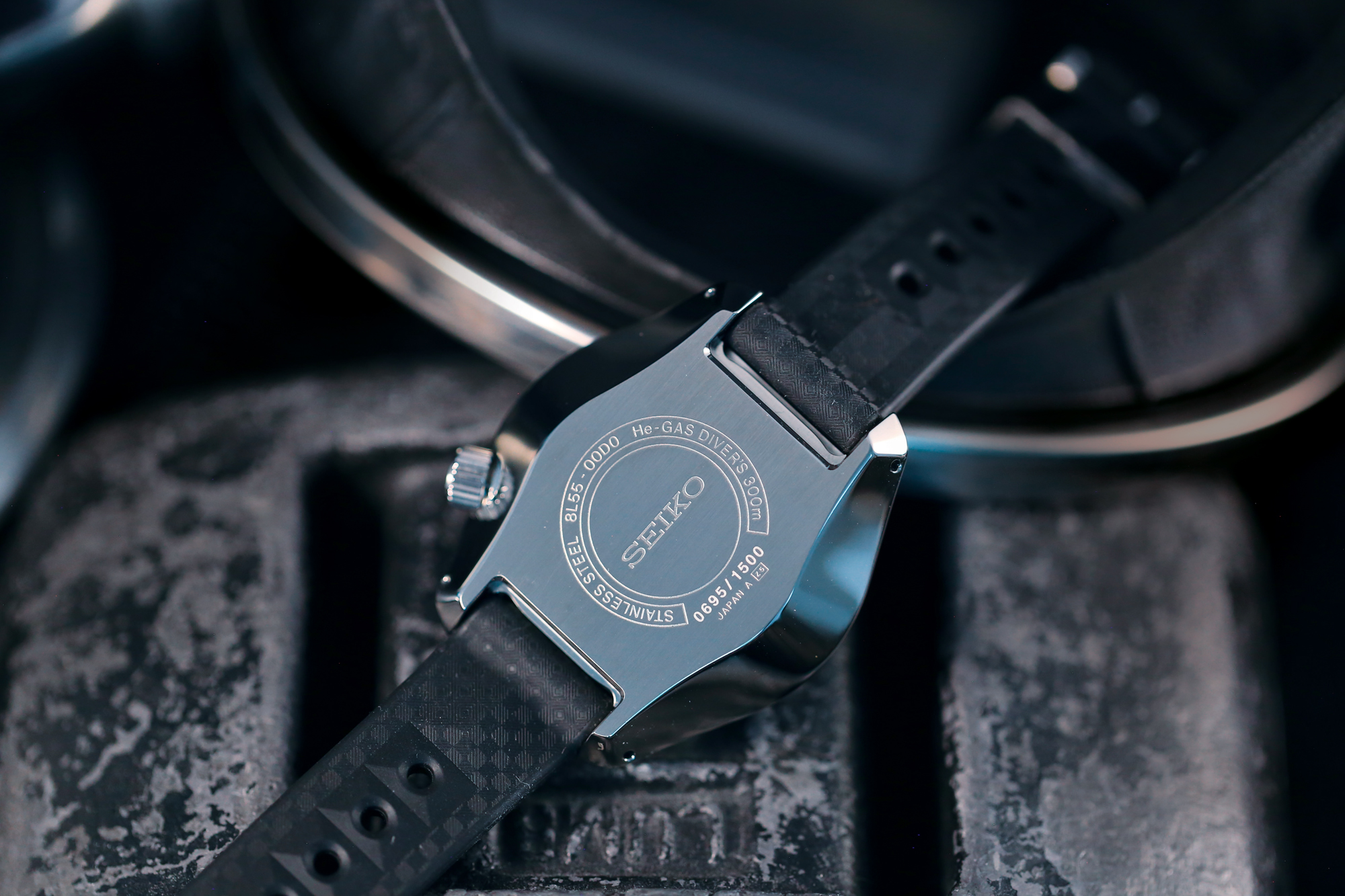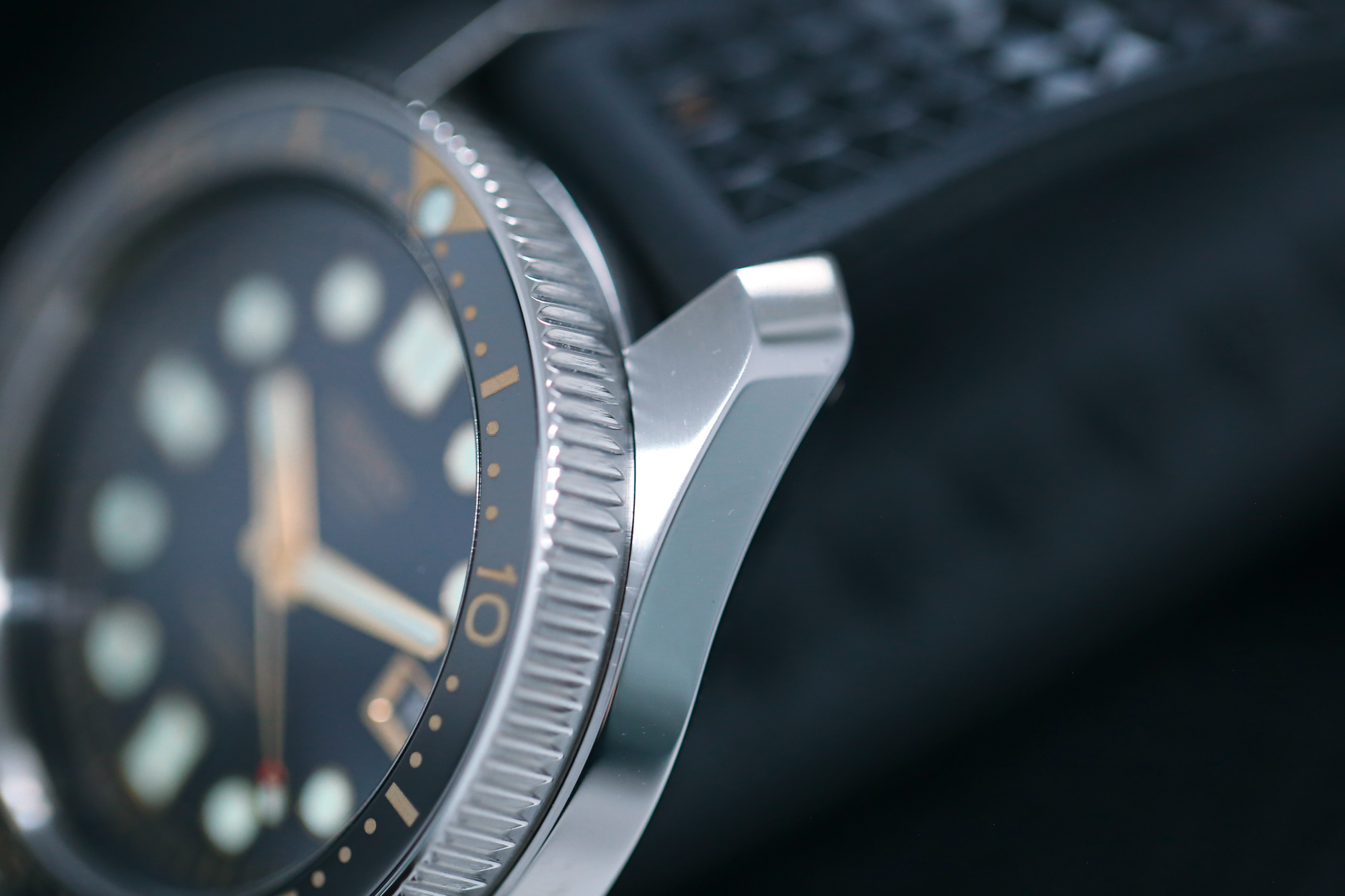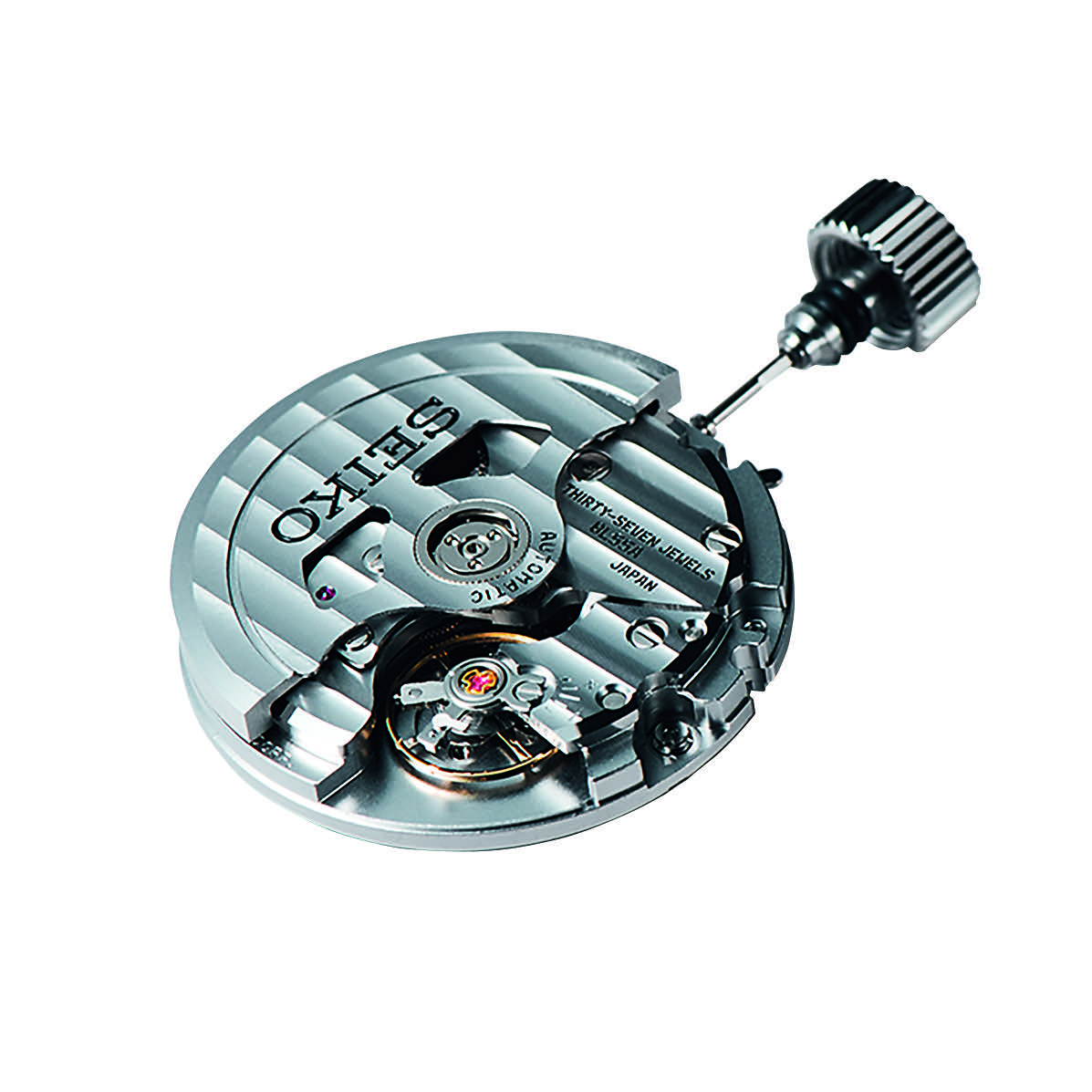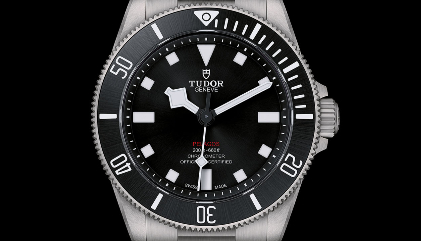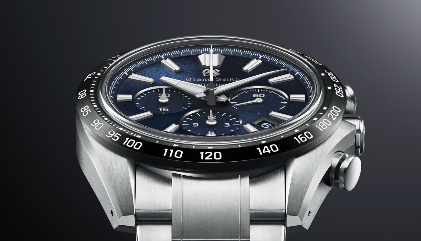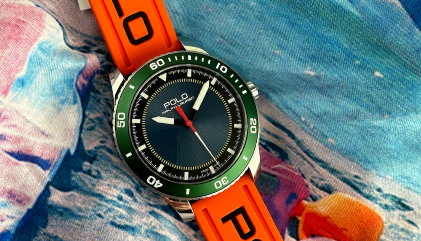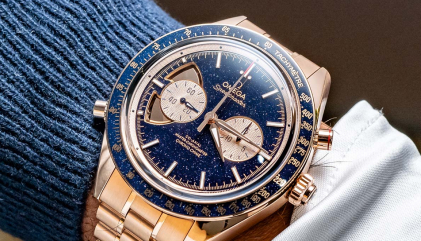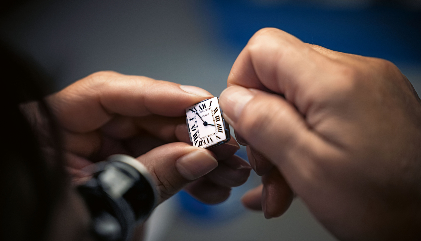In 1968, three years after the brand’s first dive watch was released (the 62MAS or Reference 6217-800x with 150-meter water resistance), Seiko’s engineers managed to raise the bar with a Hi-Beat divers’ watch with 300-meter water resistance (Reference 6159-700x). This model was not only the first dive watch to be equipped with a 10-beat high-precision automatic caliber (6159A), it also featured – like its predecessor from 1967 (Reference 6215-7000) – a case design with a one-piece structure, a screw-down crown at 4 o’clock and a rotating (albeit bidirectional) bezel. Fifty years later, Seiko decided to finally bring back one of its most sought-after dive-watch designs in a limited edition of 1,500 pieces. Another watch with similar roots, however, has already been around during the last 18 years and has built up quite a following.
The Marinemaster 300
In the year 2000, Seiko introduced the Marinemaster 300 (SBDX001) into its domestic Prospex collection (reserved for watches with professional specifications), basically a modern interpretation of the brand’s first 300-meter diver powered by the in-house Caliber 8L35 with 28,800 vph and a 50-hour power reserve. At the same time, the almost identical SBDX003 was launched as part of the historical collection, limited to only 500 pieces. Instead of a bracelet, the SBDX003 was sold exclusively with a rubber strap and, for the first time, reintroduced the typical golden indexes and hands of the 1967 model. Needless to say, the SBDX003 sold out quickly and has become almost as difficult to find as the vintage model.
The SBDX001, on the other hand, became a bit of an insider’s secret among dive-watch enthusiasts worldwide over the following years – maybe because it was almost impossible to buy outside of Japan, maybe because of its back-then unexpectedly high price of JPY 250,000 (approximately $2,250) that hinted at quality and features potentially not available anywhere else. Among these were the aforementioned in-house movement, a massive monobloc case (44.3 mm in diameter, 14.6 mm in height) without a separate caseback and the first fully variable folding clasp on a dive watch. It took Seiko more than 10 years to come to a similar conclusion and, finally, to officially start offering the Marinemaster outside of Japan as part of the recent global expansion of the brand. Today, the Marinemaster can, in most cases, even be serviced locally, since the tools required to work on the case (the movement must be accessed from the dial), have become much more readily available thanks to a global network of boutiques with specially trained staff. (In the U.S. alone, Seiko currently operates three flagship stores – in New York, Miami and, most recently, Los Angeles.)
In 2015, Seiko replaced the SBX001 with the SBDX017. The new, almost-visually identical version offered improved lume, an upgraded movement (still the 8L35, but now with MEMS-manufactured parts), a DiaShield-treated case, a laser-etched Prospex logo on the crown and a price increase of about 10 percent. In the same year, similar to the launch in 2000, Seiko also presented an even more expensive, 1,000-piece limited edition (SBDX012) with golden accents on the dial and bezel to celebrate the brand’s 50th anniversary as a manufacturer of dive watches. And another year later, Seiko launched a Europe-only, 200-piece limited edition, the SLA015, which introduced a different set of hands as well as a light blue dial.
Almost more importantly, with a still-growing international market presence and brand recognition, the year 2017 saw the debut of the most faithful reproduction of a historical diver yet: the SLA017J1 based on the 62MAS, with a list price of $3,400, and the launch of the most expensive Grand Seiko diver ever, starting at $9,600 for the standard black dial with gold accents (Reference SBGH255) and $9,800 for the limited edition with blue dial (Reference SBGH257). These three watches not only ushered in a new pricing structure but also introduced sapphire crystals (instead of Hardlex, the proprietary type of hardened mineral crystal used previously), to better meet the expectations of clients worldwide.
The End of the Marinemaster and the Return of the Hi-Beat Diver
In 2018, the green-dialed Seiko Prospex (Reference SLA019 or SBDX021), limited to 1,968 pieces, was the first model to officially replace the SBDX017 from 2015. The same model raised the retail price to $3,250 by introducing a sapphire crystal and a matching green ceramic bezel inlay to the product family. Ironically, the SLA019 also became the first of the line to no longer carry the name “Marinemaster” on the dial.
The brand headliner during this year’s Baselworld, however, was undoubtedly the Prospex 1968 Diver’s Re-Creation SLA025J1, limited to 1,500 pieces. Despite offering a similar look and dimensions as the previous models, almost every single part has been replaced and upgraded. The bezel was made taller and the inlay thinner and the texts on the dial, the width of the hands and the size of the indexes were slightly reduced, letting the matte black dial appear less busy.
The slightly bigger case (diameter: 44.8 mm, height: 15.65 mm) no longer has the brushed lateral middle section found in previous Marinemasters. Instead, it brings back the single sharp edge from the original with a fine satin finish on the top of the lugs and on the flat caseback. There’s a chance not everyone will appreciate the holes that can still be found in the lugs of the SLA025J1, but they simply are a very convenient way to change straps (especially when equipped with the so-called “fat” spring bars Seiko traditionally uses for its bracelets and straps) and remain well hidden when the watch is worn.
The immaculate mirror finishing on the case has been achieved through a method known as “Zaratsu” polishing and is protected with “DiaShield” coating – Seiko’s proprietary surface treatment that aims to offer better protection against small scratches and corrosion and promises to be two to three times harder than regular stainless steel. At the same time, the coating slightly changes the look and feel of the material, which might not be everyone’s masu of sake (and certainly makes the watch more difficult to photograph than usual).
The dial of the re-edition is almost identical to the original, with applied circular and square hour markers filled with Seiko Lumi-Brite, which contrast nicely with the matte black (or at least, dark gray) dial. At 3 o’clock is the gold-outlined date window, toward the top is the Seiko logo with the words “Automatic” and “Hi-Beat” just below, and toward the bottom, “Professional” and “300m” can be found. Outlining the dial is a slightly curved flange with minutes ring, and sweeping over it are the large, gold-colored hands and the seconds hand with the characteristic red-filled (and non-luminous) dot at the end.
18 Years in the Making
In short, the SLA025J1 is by far the most faithful reproduction of the 1967-’68 dive-watch design and one of the few automatic watches equipped with a 36,000-vph (5Hz) movement. Like the original, the watch features a one-piece case construction and a flat caseback, this time engraved with the individual number. Its wrist presence is substantial, and with a weight of 147 grams (on a rather soft rubber strap), also noticeable. Still, if you’re used to larger watches, this one sits comfortably on the wrist, and the new silicone strap (limiting aftermarket options with a lug width of only 19 mm) promises to be more durable than previous Prospex straps prone to breaking after a while.
The SLA025J1 is powered by in-house Caliber 8L55, assembled by Seiko’s watchmakers in the Shizuku-ishi Watch Studio in Morioka in the north of Japan (the same studio responsible for the mechanical Grand Seikos). This also explains the origin of the movement: the 8L55 is a variation of the Grand Seiko Caliber 9S85 introduced in 2009, with a different finishing and less stringent testing than its GS sibling. The 8L55 also uses Seiko’s MEMS (Micro Electro Mechanical Systems)-manufactured escape wheel with oil reservoirs at the end of each gear tooth and a pallet fork “made with a precision of one ten-thousandth of a millimeter,” a special metal called “Spron 610” for the hairspring and a “Spron 530” mainspring, both of which are highly resilient springs with low effects from temperature, magnetism and shock. According to Seiko, “Spron 530 delivers about 6 percent more power than its predecessor and a power reserve of five more hours while maintaining the same degree of corrosion resistance, durability, and magnetic resistance” and ensures a high level of torque to supply the power required for the increased oscillating rate. Spron 610, on the other hand, is said to offer “around twice the impact resistance, and a magnetic resistance more than three times higher.”
Like the 9S85, the 8L55 offers a 55-hour power reserve (with a single barrel) when fully wound, which represents one of the longest power reserves offered by a high-frequency watch. Although the benefits of a high-beat movement may be more imminent in a consequently more precise chronograph, a higher frequency also offers a much smoother seconds hand movement than its slower beating counterparts and can, therefore, not only be seen as a hypothetically more precise, but also as a more exquisite choice for collectors looking for more exclusive calibers in their watches.
Seiko regulates the 8L55 movement to +15 and -10 seconds per day at normal temperature range (between 5 °C/41°F and 35 °C/95°F), while the Grand Seiko Special Standard for the 9S movements offers precision of up to +4/-2 seconds per day (COSC requires an average daily rate of +6/-4). In other words, Seiko has a tendency to under promise and over deliver, but that does not help to hide the fact that, at least on paper, buyers will easily find other mechanical watches with a better-guaranteed accuracy and are left with the knowledge that the 8L55 could have been regulated to a higher standard.
The high-beat movement is most likely also the main reason why the watch is priced at $5,400. To put this into perspective, that’s the same list price as the IWC Aquatimer Automatic 300 (Reference 329001) or more than twice the amount a collector had to pay for the Marinemaster 300 in 2000. It also shows that price comparisons don’t really work in this case: the same Aquatimer is equipped with a base caliber (ETA 2892-A2 with 28,800 vph) and a more complex case construction while the SLA025J1 comes with the 8L55 Hi-Beat movement and monobloc case and is produced in-house by one of the few fully integrated manufacturers. More importantly, since the model’s reintroduction in 2000, Seiko now has a much bigger loyal fan base worldwide and has done quite an excellent job of explaining the brand and its rich heritage to a larger audience, and, therefore, increased its brand appreciation and value significantly. Which means that the SLA025J1 will most likely be sold out as quickly as the previous vintage re-editions, especially since it is the watch everyone has been secretly waiting for since 2000.
What remains to be seen is where Seiko is taking the model from here: a significantly less-expensive 1967 300-meter re-edition with an 8L35 movement, or a new “Marinemaster” base model (like the rumored black version with orange text), for example, could have an equally strong impact on how the price-value ratio of this watch is going to be seen in the coming years. For now, the SLA025J1 may not be the most affordable dive watch from Seiko, but it is certainly the one with the brand’s most sought-after design and movement. The finish and build quality are excellent (but not without small flaws in the model pictured here); the size of the watch is substantial (but still comfortable to wear with the right wrist size), offering a vintage design with a great wrist presence. And, at least until now, all of Seiko’s historical dive-watch limited editions have sold out rather quickly.
In a nutshell, for those still unfamiliar with the brand, the SLA025J1 might be too expensive on first sight, and for others, too close to the original, but for 1,500 collectors it’s undoubtedly going to be the best way to own Seiko’s best-designed diver again.
Okaerinasai, 6159!





